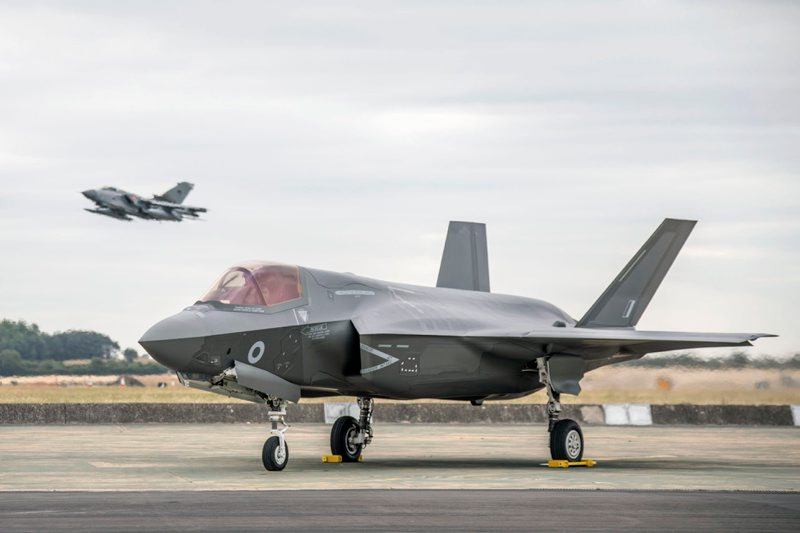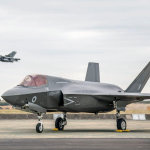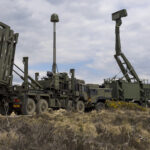The United Kingdom’s procurement of the Lockheed Martin F-35 Lightning II, encompassing both the F-35B and F-35A variants, reflects a complex interplay of strategic, operational, political, and industrial considerations spanning decades. The 1998 decision to select the F-35B, driven by industrial pressures and inter-service rivalries, laid the foundation for the UK’s Carrier Enabled Power Projection (CEPP) capability via the Royal Navy’s Queen Elizabeth-class aircraft carriers. The recent announcement to procure 12 F-35A jets, as part of the planned 138 F-35s, introduces a tactical nuclear role for the Royal Air Force (RAF) within NATO’s nuclear-sharing framework. This paper examines the 1998 F-35B selection, the rationale for excluding the F-35A and F-35C, the motivations for the 2025 F-35A acquisition, and the multifaceted challenges, including impacts on the Global Combat Air Programme (GCAP), infrastructure, training, sovereignty, and CEPP.
It argues that while the F-35A’s assignment to 207 Squadron (OCU) and short-term cost savings address immediate needs, the legacy of 1998 decisions, combined with current policy shifts, risks undermining GCAP, increasing long-term costs, and enables Lockheed Martin to exploit tensions with GCAP partners Italy and Japan, jeopardising the our strategic autonomy and future air combat capabilities.
The 1998 Decision to Select the F-35B and Inter-Service Pressures
The UK’s commitment to the F-35B originated in the late 1990s, formalised in the 1998 Strategic Defence Review (SDR), which prioritised restoring a credible carrier strike capability lost with the retirement of the Invincible-class carriers and Sea Harrier FA2 by 2006. As a Tier 1 partner in the US-led Joint Strike Fighter (JSF) programme, the UK evaluated three F-35 variants: the F-35A (conventional take-off and landing), F-35B (Short Take-Off and Vertical Landing, STOVL), and F-35C (carrier-based, catapult-assisted take-off but arrested recovery, CATOBAR). The Royal Navy initially favoured the F-35C, which offered greater range (1,200 nautical miles versus 900 for the F-35B), higher payload, and compatibility with CATOBAR systems, aligning with ambitions for a more capable Queen Elizabeth-class carrier design. However, political and industrial pressures tipped the scales toward the F-35B.
Rolls-Royce exerted significant influence, advocating for the F-35B due to its role in developing the LiftSystem for STOVL operations, securing substantial workshare and economic benefits for British industry. Other UK firms, including BAE Systems, supported the F-35B, as it ensured integration with the Queen Elizabeth-class carriers’ STOVL configuration, avoiding costly CATOBAR retrofits estimated at £2 billion per carrier. The Labour government, under Tony Blair, prioritised industrial jobs and domestic manufacturing, aligning with the SDR’s emphasis on economic dividends from defence spending. The F-35B’s selection promised thousands of jobs in Rolls-Royce’s Bristol facilities and BAE’s supply chain, outweighing the Royal Navy’s operational arguments for the F-35C.

Inter-service rivalries further shaped the decision. The RAF, keen to consolidate its dominance in fixed-wing aviation, supported the F-35B’s joint RAF-RN operation, arguing it could serve both carrier and land-based roles, simplifying logistics and training. This contrasted with the F-35C, which would have entrenched the Royal Navy-centric carrier operations. To fund the F-35B programme and the carriers’ development, the MoD faced intense inter-service pressures, leading to the controversial early retirement of the Harrier fleet. The RAF lobbied to retire the Royal Navy’s FA2 (Sea Harrier) by 2006, citing its limited air-to-air capabilities compared to the F-35B’s multi-role potential. Subsequently, the 2010 SDSR accelerated the retirement of the RAF’s Harrier GR9 fleet, completed by 2011, despite its proven effectiveness in Afghanistan and Libya. RAF leaders argued that resources should prioritise Tornado GR4 (based on utility in Afghanistan), Typhoon enhancements, and F-35B procurement, framing the Harrier as redundant. These decisions marginalised Royal Navy aviation, sparking tensions with the RN, which viewed the Harrier losses as a strategic blow to its autonomy and operational flexibility. (Sources: House of Commons Defence Committee, 1998 SDR; Jane’s Defence Weekly, 1998-2010).
The F-35B’s selection and Harrier retirements came at significant cost. The F-35B’s shorter range and lower payload compared to the F-35C were accepted as trade-offs for carrier compatibility and industrial benefits. The Queen Elizabeth-class carriers’ STOVL design, locked in by 1999, constrained future flexibility, while the Harrier’s retirement created a decade-long carrier strike gap until the F-35B’s introduction in 2020. These choices reflected a politically driven compromise prioritising industrial and RAF interests over the Royal Navy’s long-term operational needs.
Exclusion of the Initial F-35A in Initial Plans Exclusion
In 1998 and beyond, the F-35A was not considered a priority for several reasons. Its conventional design was incompatible with the Queen Elizabeth-class carriers, rendering it irrelevant to CEPP objectives. The MoD sought to maintain a commonality within the F-35 fleet to simplify logistics, training, and maintenance, as operating multiple variants would increase costs and complexity. The RAF’s existing Tornado and Eurofighter Typhoon fleets fulfilled roles like air superiority and long-range strike, albeit without the F-35’s stealth capabilities. The UK’s nuclear deterrent was exclusively submarine-based via Trident, with no need for air-delivered nuclear weapons since the RAF’s retirement of WE.177 bombs in the 90’s. The MoD argued that the F-35B maximized operational flexibility for land- and sea-based missions while aligning with fiscal constraints and the focus on carrier strike.
The 2025 Decision to Procure F-35A Aircraft
On 24 June the Prime Minister Sir Keir Starmer announced the procurement of 12 F-35A jets at the NATO summit in The Hague, marking a significant policy shift. The decision is driven by (perceived) cost savings and the reintroduction of a tactical nuclear role for the RAF. The F-35A is 15-25% cheaper to procure and 8% less expensive to operate than the F-35B, offering short-term fiscal relief. Critically, it is the only F-35 variant to carry the US-designed nuclear B61-35 bomb, enabling the UK to rejoin NATO’s nuclear-sharing mission, a role absent since the Cold War. This responds to heightened nuclear risks from Russia, particularly following its actions in Ukraine and nuclear deployments in Belarus. The 2025 Strategic Defence Review (SDR) emphasised a “sub strategic” capability to deter battlefield escalation, complementing Trident.
The MoD has assigned the 12 F-35As to 207 (OCU) Sqn, the Operational Conversion Unit at RAF Marham, primarily for training RAF and Royal Navy pilots, with a secondary nuclear role. This “frees up” F-35Bs for frontline carrier duties, enhancing CEPP. However, the nuclear mission remains “muddled,” with uncertainty about operational integration, weapons storage, and readiness timelines. The MoD’s decision not to upgrade the Voyager tanker fleet with boom refuelling systems (confirmed today by Angela Eagle) for the F-35A limits its range and strategic utility. These factors, combined with impacts on GCAP, introduce significant challenges.
The Nuclear Role, NATO, and Sovereignty Concerns
The F-35A’s nuclear capability centres on the B61-12 bomb, a US-controlled weapon under NATO’s nuclear-sharing programme, requiring US and NATO authorisation for use. This further sacrifices UK sovereignty. Critics argue this prioritises NATO interoperability over autonomy, possibly as a gesture to reassure a skeptical US administration under President Donald Trump, who has questioned NATO’s Article 5 commitments. The decision aligns with NATO’s push for increased defence spending (to 5% of GDP by 2035) and burden-sharing amid doubts about US reliability.
The nuclear role’s ambiguity, described as “muddled”, stems from the F-35A’s primary training focus with 207 Sqn, raising doubts about operational nuclear readiness. Uncertainty persists about whether F-35As will integrate UK conventional weapons or remain limited to the B61-12, potentially rendering them a niche NATO asset. Infrastructure upgrades at RAF Marham, the base for F-35As and (potentially) B61-12 bombs, are costly. RAF Marham’s former WE.177 WS3 vaults may require refurbishment, or the UK may rely on RAF Lakenheath’s US-operated vaults, deepening US control. These costs could divert funds from GCAP or additional F-35Bs.
Training for nuclear roles is a hurdle. The RAF has not operated nuclear-capable aircraft since the mid 90’s, requiring specialised training in weapons handling, mission planning, and NATO nuclear command integration. Using 207 Sqn for F-35A training streamlines pilot conversion but strains resources, as nuclear training demands additional expertise. The RAF’s personnel shortages, exacerbated by operating two F-35 variants, further complicate readiness, potentially delaying nuclear capability for years.
Impact on CEPP and Operational Challenges
The RAF’s advocacy for the F-35A echoes its 1998 push for fixed-wing dominance, clashing with the Royal Navy’s F-35B priority for carrier operations. The F-35A’s assignment to 207 Sqn mitigates resource conflicts by focusing on training but operating two variants with limited commonality splits resources. With only 33 of 48 Tranche 1 F-35Bs delivered so far and with serviceability rates below 60%, personnel shortages could reduce F-35Bs available for CEPP, undermining its effectiveness.

The MoD’s decision (confirmed in Parliament on 25 June) not to retrofit the Voyager fleet with boom refueling systems for the F-35A limits its range advantage, critical for deep-strike or B61-12 missions. Without AAR, the F-35A relies on USAF tankers at RAF Mildenhall, eroding UK independence. Israel’s F-35A success in long-range missions highlights this gap. Developing a probe-equipped F-35A was deemed too costly, constraining utility.
Challenges to GCAP and Lockheed Martin’s Leverage
The F-35A procurement threatens GCAP, the trilateral programme with Italy and Japan to develop a sixth-generation fighter by (unlikely) 2035, led by BAE Systems, Leonardo, and Mitsubishi Heavy Industries. GCAP is central to the UK’s long-term air combat strategy, replacing Typhoon and ensuring technological sovereignty. However, F-35A-related costs including nuclear infrastructure, training, and maintenance (could) divert funding from GCAP, risking delays or capability compromises. The 1998 industrial focus on Rolls-Royce and BAE Systems echoes in GCAP’s economic stakes, but budget constraints could undermine UK leadership.
Lockheed Martin can exploit this to undermine GCAP, targeting Italy and Japan, both F-35 operators. Italy, with 90 F-35s (including F-35As), faces budget pressures and may be swayed by Lockheed Martin’s offers of F-35 maintenance hubs or technology transfers, prioritising near-term capabilities over GCAP. Japan, with 147 F-35s (mostly F-35As), relies on US security guarantees and could be tempted by F-35A nuclear role enhancements, aligning with US Indo-Pacific strategy. Lockheed Martin may frame GCAP as riskier and costlier, leveraging favourable F-35 pricing or NATO interoperability incentives. The UK’s F-35A pivot signals further US system reliance, weakening its GCAP leadership. Italy and Japan may question UK commitment, risking programme fractures and entrenching F-35 dominance.
Cost Dynamics of F-35A as a Training Platform
Using the F-35A with 207 Sqn for training offers short-term airframe savings (£65-80 million per unit versus £100 million for F-35B), preserving F-35B airframe life for CEPP. However, long-term maintenance and lifecycle costs rise due to the F-35A’s stealth coatings, sensors, and software, estimated at £30,000 per flight hour. Operating two variants doubles logistics, training, and spares, negating savings. The lack of Voyager AAR compatibility adds costs via USAF tanker reliance. Lifecycle costs could exceed £1 billion per aircraft, straining the MoD and diverting GCAP funds.
Policy Shifts and Strategic Implications
The F-35A procurement reflects a “NATO-first” shift in the 2025 SDR, prioritising collective defence to counter Russia and diversify NATO nuclear options. However, the “muddled” nuclear role, limited by 207 Sqn’s training focus and AAR constraints, undermines deterrence. The B61-12’s US ownership sacrifices sovereignty and may be a (another) concession to maintain NATO cohesion under a Trump administration skeptical of alliances. The F-35A could be a “sop” to Trump, securing US support.

The 65,000-tonne future flagship will spend the next month conducting further sea trials, which will include testing with rotary wing aircraft, learning about their behaviour flying to and from the ship in a range of conditions.
Commanding Officer of HMS Queen Elizabeth, Captain Jerry Kyd, said: After the excitement of our commissioning ceremony in December, my ships company and our industry partners are looking forward to taking the ship to sea to conduct First of Class Rotary Wing Flying Trials.
The Queen Elizabeth Class Carriers are the biggest warships ever built for the Royal Navy – four acres of sovereign territory, deployable across the globe to serve the United Kingdom on operations for 50 years.
HMS Queen Elizabeth and HMS Prince of Wales will be the most advanced warships in the Royal Navy fleet.
They are the future flagships of the nation. Initially the ships will carry helicopters. The vast flight deck and hangar can accommodate any helicopter in Britains military inventory.
From 2020, however, our punch will be delivered by the F35 Lightning II, the worlds most advanced stealth fighter-bomber.
The 1998 F-35B decision, driven by industrial and RAF pressures, set a precedent for short-term political gains over long-term strategy, echoed in the F-35A’s impact on GCAP and sovereignty. Lockheed Martin’s leverage over Italy and Japan threatens sixth-generation fighter development, locking the UK into F-35 dependency. Increased F-35A lifecycle costs constrain investments in autonomous systems, cyber, or naval modernisation.
Conclusion (personal view)
The UK’s procurement of 12 F-35A jets, addresses short-term savings and NATO nuclear needs but compounds challenges rooted in the 1998 F-35B decision, driven by Rolls-Royce, BAE Systems, and RAF pressures over the Royal Navy’s F-35C preference. The Harrier’s retirement to fund RAF fixed-wing priorities foreshadowed current resource strains. The lack of Voyager AAR upgrades and “muddled” nuclear role limit F-35A utility, while operating two variants risks CEPP effectiveness. Potentially diverting funds from GCAP enables Lockheed Martin to exploit tensions with Italy and Japan, undermining UK leadership in sixth-generation fighters (why wouldn’t they). Short-term F-35A savings are offset by long-term lifecycle costs, threatening fiscal sustainability. The sacrifice of sovereignty over the B61-12 and US dependency raise autonomy concerns. The UK must navigate these trade-offs to maintain a robust defence posture in an era of radical uncertainty.
Lee Pilgrim
Lee Pilgrim tweets as @Mtarfalee




